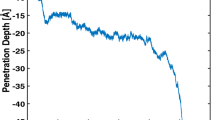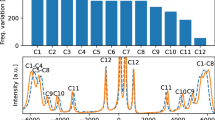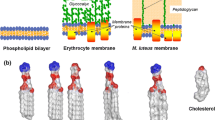Abstract
We present results of Martini coarse-grained force field simulations to estimate the potentials of mean force for a series of recently screened spontaneous membrane-translocating peptides, SMTPs. We consider model bilayer composed of POPC and POPG, the latter providing the anionic component as used in experimental studies. We observe a significant barrier for translocation in the case of the canonical cationic cell-penetrating peptide nona-arginine, ARG9. In the case of the TP1, TP2, and TP3 peptides, potentials of mean force are systematically lower relative to the ARG9 case. Though the barriers predicted by the simulations, on the order of 20 kcal/mol, are still rather large to recapitulate the experimental kinetics of internalization, we emphasize that the qualitative trend of reduction of barrier heights is a significant result. Decomposition of the PMFs indicates that though there is a substantial entropic stability when the peptides reside at bilayer center, barriers as predicted from these force field-based studies are largely determined by enthalpic (potential energy) interactions. We note that the binding of the SMTPs is critically dependent on the mix of hydrophilic and hydrophobic residues that constitute the amino acid motif/sequence of these peptides. For the cationic ARG9 which only contains hydrophilic residues, there is no tight binding observed. The specific motif \(\varPhi \mathrm{R} \varPhi \varPhi \mathrm{R}\) (where \(\varPhi\) is a general residue) is a potential sequence in drug/peptide design. The SMTPs with this motif are able to translocate into membrane at a significantly lower free energy cost, compared to the negative control peptides. Finally, we compare the different membrane perturbations induced by the presence of the different peptides in the bilayer center. In some cases, hydrophilic pores are observed to form, thus conferring stability to the internalized state. In other cases, SMTPs are associated only with membrane defects such as induced membrane curvature. These latter observations suggest some influence of membrane rigidity as embodied in the full range of membrane undulatory modes in defining pore-forming propensities in bilayers.







Similar content being viewed by others
References
Bangel U (ed) (2006) Handbook of cell penetrating peptides, 2nd edn. CRC, Boca Raton
Bechara C, Sagan S (2013) Cell-penetrating peptides: 20 years later, where do we stand? FEBS Lett 587:1693–1702
Berendsen HJC, Postma JPM, Gunsteren WFV, DiNola A, Haak JR (1984) Molecular dynamics with coupling to an external bath. J Chem Phys 81:3684–3690
Cruz J, Mihailescu M, Wiedman G, Herman K, Searson P, Wimley K, Hristova William (2013) A membrane-translocating peptide penetrates into bilayers without significant bilayer perturbations. Biophys J 104(11):2419–2428
DeJong DH, Singh G, Bennett WFD, Arnarez C, Wassenaar TA, Schäfer LV, Periole X, Tieleman DP, Marrink SJ (2013) Improved parameters for the martini coarse-grained protein force field. J Chem Theory Comput 9(1):687–697
Freites JA, Tobias DJ, White SH (2006) A voltage-sensor water pore. Biophys J 91(11):L90–L92
Green M, Loewenstein PM (1988) Autonomous functional domains of chemically synthesized human immunodeficiency virus tat trans-activator protein. Cell 55:1179–1188
He J, Hristova K, Wimley WC (2012) A highly charged voltage-sensor helix spontaneously translocates across membranes. Angew Chem Int Ed Engl 51(29):7150–7153
He J, Kauffman WB, Fuselier T, Naveen SK, Voss TG, Hristova K, Wimley WC (2013) Direct cytosolic delivery of polar cargo to cells by spontaneous membrane-translocating peptides. J Biol Chem. doi:10.1074/Jbc.M113.488312
Hess B, Bekker H, JCBerendsen H, GEMFraaije J (1997) LINCS: a linear constraint solver for molecular simulations. J Comput Chem 18(12):1463–1472
Hu Y, Ou S, Patel S (2013) Free energetics of arginine permeation into model dmpc lipid bilayers: coupling of effective counterion concentration and lateral bilayer dimensions. J Phys Chem B 117:11641–11653
Hu Y, Liu X, Sinha SK, Patel S (2014) Translocation thermodynamics of linear and cyclic nonaarginine into model dppc bilayer via coarse-grained molecular dynamics simulation: Implications of pore formation and nonadditivity. J Phys Chem B 118(10):2670–2682
Huang K, García AE (2013) Free energy of translocating an arginine-rich cell-penetrating peptide across a lipid bilayer suggests pore formation. Biophys J 104(2):412–420
Järver P, Langel Ü (2006) Cell-penetrating peptides—a brief introduction. Biochim Biophys Acta 1758:260–263
Jiao CY, Delaroche D, Burlina F, Alves ID, Chassaing G, Sagan S (2009) Translocation and endocytosis for cell-penetrating peptide internalization. J Biol Chem 284(49):33957–33965
Kosuge M, Takeuchi T, Nakase I, Jones AT, Futaki S (2008) Cellular internalization and distribution of arginine-rich peptides as a function of extracellular peptide concentration, serum, and plasma membrane associated proteoglycans. Bioconjug Chem 19(3):656–664
Kumar S, Rosenberg JM, Bouzida D, Swendsen RH, Kollman PA (1992) The weighted histogram analysis method for free-energy calculation s on biomolecules. i. The method. J Comp Chem 13(8):1011–1021
Laettig-Tuennemann G, Prinz M, Hoffmann D, Behlke J, Palm-Apergi C, Morano I, Herce HD, Cardoso MC (2011) Backbone rigidity and static presentation of guanidinium groups increases cellular uptake of arginine-rich cell-penetrating peptides. Nature Commun 2:1–6
Lazaridis T, III JML, PeBenito L (2014) Implicit membrane treatment of buried charged groups: application to peptide translocation across lipid bilayers. Biochim Biophys Acta. http://dx.doi.org/10.1016/j.bbamem.2014.01.015
Lin J, Motylinski J, Krauson AJ, Wimley WC, Searson PC, Hristova K (2012) Interactions of membrane active peptides with planar supported bilayers: an impedance spectroscopy study. Langmuir 28(14):6088–6096
Lundberg P, Langel Ü (2003) A brief introduction to cell-penetrating peptides. J Mol Recognit 16:227–233
Marks JR, Placone J, Hristova K, Wimley WC (2011) Spontaneous membrane-translocating peptides by orthogonal high-throughput screening. J Am Chem Soc 133(23):8995–9004
Marrink SJ, Vries AHD, Mark AE (2004) Coarse grained model for semiquantitative lipid simulations. J Phys Chem B 108(2):750–760
Monticelli L, Kandasamy SK, Periole X, Larson RG, Tieleman DP, Marrink SJ (2008) The martini coarse-grained force field: extension to proteins. J Chem Theory Comput 4(5):819–834
Notman R, Anwar J, Briels W, Noro MG, den Otter W (2008) Simulations of skin barrier function: free energies of hydrophobic and hydrophilic transmembrane pores in ceramide bilayers. Biophys J 95(10):4763
Pavan S, Berti F (2011) Short peptides as biosensor transducers. Anal Bioanal Chem 402:3055–3070
Saalik P, Niinep A, Pae J, Hansen M, Lubenets D, Langel U, Pooga M (2011) Penetration without cells: membrane translocation of cell-penetrating peptides in the model giant plasma membrane vesicles. J Control Release 153(2):117–125
Schmidta N, Mishrab A, Laia GH, Wong GC (2010) Arginine-rich cell-penetrating peptides. FEBS Lett 584:1806–1813
Schow EV, Freites JA, Cheng P, Bernsel A, von Heijne G, White SH, Tobias DJ (2011) Arginine in membranes: the connection between molecular dynamics simulations and translocon-mediated insertion experiments. J Membr Biol 239(1–2):35–48
Shin MC, Zhang J, Min KA, Lee K, Byun Y, David AE, H He VCY (2013) Cell-penetrating peptides: achievements and challenges in application for cancer treatment. J Biomed Mater Res A 00:00–00
Tunnemann G, Ter-Avetisyan G, Martin RM, Stockl M, Herrmann A, Cardoso MC (2009) Live-cell analysis of cell penetration ability and toxicity of oligo-arginines. J Biol Chem 14(4):469–476
Walrant A, Matheron L, Cribier S, Chaignepain S, Jobin ML, Sagan S, Alves ID (2013) Direct translocation of cell-penetrating peptides in liposomes: a combined mass spectrometry quantification and fluorescence detection study. Anal Biochem 438(1):1–10
Yesylevskyy SO, Schäfer LV, Sengupta D, Marrink SJ (2010) Polarizable water model for the coarse-grained martini force field. PLoS Comput Biol 6(6):e1000810
Zorko M, Langel U (2005) Cell-penetrating peptides: mechanism and kinetics of cargo delivery. J Mol Recognit 57:529–545
Acknowledgments
The authors acknowledge support from the National Science Foundation (CAREER:MCB:1149802). Computational resources are acknowledged via support from National Institutes of Health COBRE:P20-RR015588 in the Chemical Engineering Department and COBRE:P20-RR017716 in the Department of Chemistry and Biochemistry at the University of Delaware. S. P. thanks N. Patel for fruitful discussion and encouragement for the duration of this work.
Author information
Authors and Affiliations
Corresponding author
Electronic supplementary material
Below is the link to the electronic supplementary material.
Rights and permissions
About this article
Cite this article
Hu, Y., Patel, S. Structural and Thermodynamic Insight into Spontaneous Membrane-Translocating Peptides Across Model PC/PG Lipid Bilayers. J Membrane Biol 248, 505–515 (2015). https://doi.org/10.1007/s00232-014-9702-8
Received:
Accepted:
Published:
Issue Date:
DOI: https://doi.org/10.1007/s00232-014-9702-8




